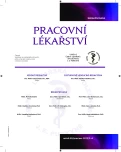Effects of glass fibers on selected parameters of respiratory tract in experimental conditions
Authors:
Hurbánková Marta 1; Ďungelová Silvia 1; Černá Silvia 1; Tátrai Erzsébet 2; Wimmerová Soňa 1; Moricová Štefánia 1
Authors‘ workplace:
Slovenská zdravotnícka univerzita, Bratislava, Slovensko, doc. MUDr. Štefánia Moricová, PhD., MPH, mimoriadny profesor, dekanka Fakulty verejného zdravotníctva
1; National Institute of Environmental Health, Budapešť, Maďarsko
2
Published in:
Pracov. Lék., 65, 2013, No. 3-4, s. 113-120.
Category:
Original Papers
*Výsledky práce boli prezentované na konferencii „Životné podmienky a zdravie“ v Dolnom Smokovci, 2012.
Overview
Glass fibers are non - crystalline, fibrous inorganic silicates, currently applied in many industrial branches as a substitute of carcinogenic asbestos. Problem of toxicity glass fibers are the subject of many experimental and epidemiological studies. The aim of our study was to find out the effects of glass fibers in lung tissue in terms of inflammatory and cytotoxic parameters of bronchoalveolar lavage (BAL) after exposure of 2, 30, 90 days and results compared with the control group.
Exposed group:
animals were instilled with 4 mg glass fibers in 0.4 ml saline solution/animal, the control group with 0.4 ml saline solution. Wistar rats were sacrificed and bronchoalveolar lavage (BAL) interventions were performed after instillation – 2, 30, 90 days. Following BAL parameters were examined: histology of lung tissues, total count of leukocytes (Le) and alveolar macrophages (AM), differential cell count (% of polymorphonuclears – PMN, % of – AM and % of lymphocytes – Ly ), % immature forms of AM, % binucleated cells, phagocytic activity and viability of AM.
The results of our study indicate that the glass fibers compared with the control group saline significantly affect especially inflammatory parameters in all time points (in the acute – 2 days in the sub-acute phases – 30 and 90 day exposure), which means that even after 90 days after instillation of glass fibers in the lungs of experimental animals still persist and cause an inflammatory reaction.
Keywords:
glass fibers – bronchoalveolar lavage – inflammatory and cytotoxic parameters – intratracheal instillation
Sources
1. APFE – European Glass Fibre Producers Association. Continuous Filament Glass Fibre Human Health [online], 2003. Dostupné na www: <http://www.ppg.com/glass/fiberglass/Documents/apfe.pdf>.
2. Beňo, M., Hurbánková, M., Černá, S., Dušinská, M., Volkovová, M., Staruchová, M., Barančoková, M., Kažimírová, A., Kováčiková, Z., Mikulecký, M., Kyrtopoulos, A. S. Multinucleate cells (MNC) as sensitive semiquantitative biomarkers of the toxic effect after experimental fibrous dust and cigarette smoke inhalation by rats. Exp. Toxicol. Pathol., 2005, 57, 1, s. 77–87.
3. Buchancová, J. Profesionálna expozícia a zhubné nádory dýchacieho systému so zameraním na karcinóm pľúc. In Kavcová, E., Halašová, E., Dzian, A. (ed.) Karcinóm pľúc. Vyd. UK v Bratislave, Jeséniova lekárska fakulta v Martine, 2010, 674 s., ISBN 978-80-88866-78-7.
4. Dziedzic, D., Wheeler, C. S., Gross, K. B. Bronchoalveolar lavage: detecting markers of lung injury. In M. Corn, Ed. Handbook of Hazardous Materials. Academic Press: New York 1993, p. 99–111, ISBN 0-12-189410-X.
5. Formůsek, L., Větvička, V., Kopeček, J. Fagocytóza leukocytů v periferní krvi – nová jednoduchá metoda. Imunologický zpravodaj, 1982, roč. 13 s. 67–68.
6. Guber, A., Lerman, S., Lerman, Y., Ganor, E. et al. Pulmonary Fibrosis in a Patient With Exposure to Glass Wool Fibres. American Journal of Industrial Medicine, 2006, vol. 49, no. 12, p. 1066–1069, ISSN 0271-3586.
7. Hurbánková, M., Kaiglová, A. Compared effects of asbestos and wollastonite fibrous dusts on various biological parameters measured in bronchoalveolar lavage fluid. J. Trace and Microprobe Techniques, 1999, 17, 2, pp. 233–243.
8. Hurbánková, M. Niektoré nové poznatky v oblasti profesionálnej prašnej expozície a pľúcnych ochorení I. Vláknité prachy. Studia pneumologica et phtiseologica, 1999, roč. 59, č. 3, s. 99–103, ISSN 0371-2222.
9. Hurbánková, M., Tátrai, E., Černá, S., Six, É., Kováčiková, Z., Kyrtopoulos, S. Inflammatory and cytotoxic effects as well as histological findings of selected industrial fibrous dusts in Fischer rats after intratracheal instillation. Biologia, 2004, 59, 6, s. 761–771.
10. Hurbánková, M. Použitie bronchoalveolárnej laváže pri pľúcnych ochoreniach vzniknutých po expozícii minerálnym prachom v experimente a u ľudí. České pracovní lékařství, 2005, roč. 6, č.1, s. 37–41, ISSN 1212-6721.
11. Hurbánková, M. Keramické vlákna – vlastnosti, použitie a vplyv na respiračný trakt. České pracovní lékařství, 2006, 7, 4, s. 206–211, ISSN 121-6721.
12. Hurbánková, M., Černá, S., Beňo, M. et al. Kombinovaný účinok keramických vlákien a fajčenia z hľadiska vybraných zápalových a cytotoxických parametrov bronchoalveolárnej laváže a histologických nálezov v experimente. Pracov. Lék., 2010, 62, 3, s. 102–108, ISSN 0032-6291.
13. Chajdiak, J. Štatistika jednoducho. Vyd. Bratislava: Statis, 2003, 196 s., ISBN 80-85659-28-X.
14. Chlap, Z., Kopinski, P., Gil, K. Proposal of new cytological entity: Macrophagic alveolotis (Alveolitis Macrophagica) in bronchoalveolar lavage analysis. Abstract Book from 6th International Conference On Bronchoalveolar Lavage, Corfu, June 24–27, 1998, p. 31.
15. IARC Monographs on the Evaluation of Carcinogenic Risks to Humans. Man-Made-Mineral Fibres and Radon, 1988, Lyon, vol. 43, 300 p.
16. IARC Monographs on the Evaluation of Carcinogenic Risks to Humans. Man-Made Vitreous Fibres, Lyon, France, vol. 81, 2002, 403 p.
17. Morimoto, Y., Tanaka, I. In vivo studies of Mann-made Mineral Fibers – Fibrosis – Related Factors. Industrial Health, 2001, vol. 39, p. 106–113.
Labels
Hygiene and epidemiology Hyperbaric medicine Occupational medicineArticle was published in
Occupational Medicine

2013 Issue 3-4
Most read in this issue
- Syndrome of carpal tunnel
- Hypertension disease and health capability for work
- Health risks of exposure to dust at work
- Effects of glass fibers on selected parameters of respiratory tract in experimental conditions
